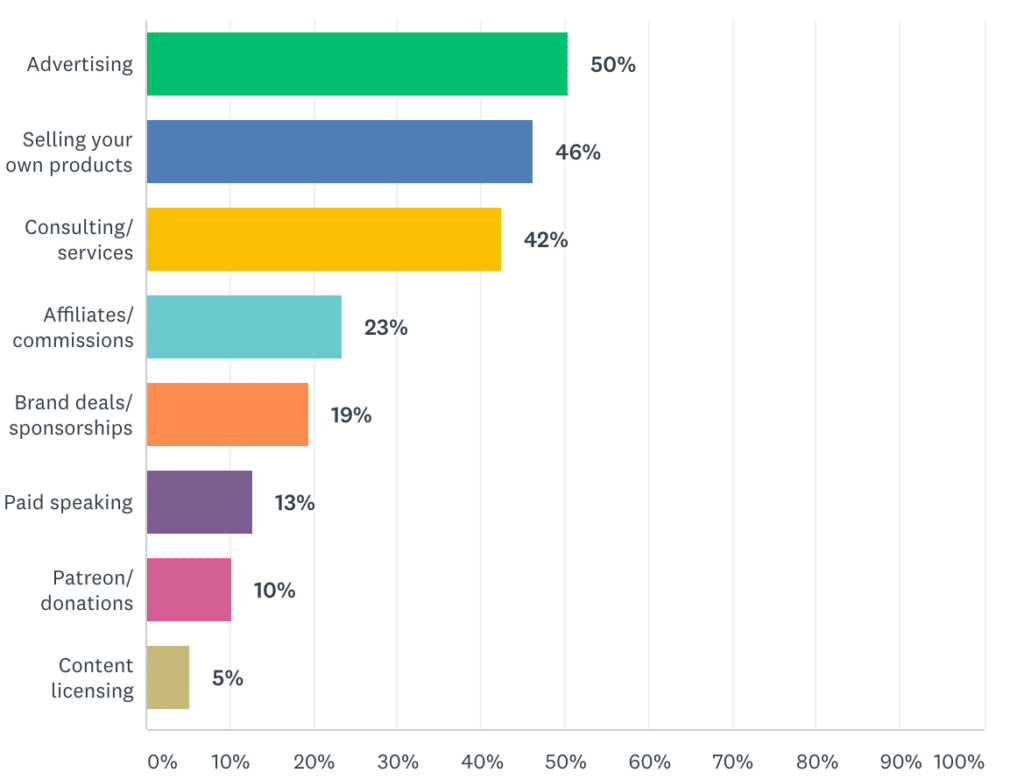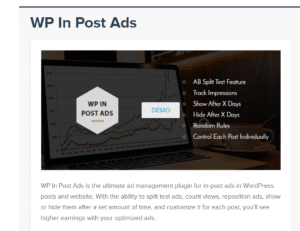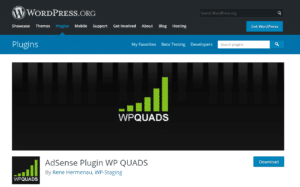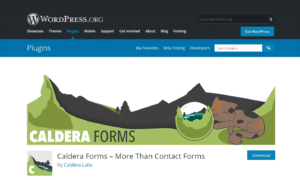Our company, FixRunner, provides WordPress support for hundreds of happy customers across the globe, and many of our clients are running successful blogs. Most started small, blogging as a hobby. But, some of them have grown their blogs into real businesses that make significant amounts of money every month.
By working on their sites, we have started noticing repeating patterns. Many successful blogs follow a similar scheme that leads them from creating written content to monetizing it. We don’t know if they follow the same route deliberately, or unconsciously, but the fact is that most of them earn money in similar ways.
Still, monetization is not the only thing they have in common. Successful bloggers share one more thing – freedom. They get to choose their own working hours, and they get to work from wherever they want. And of course, no annoying bosses towering over their heads. No commuting and endless meaningless tasks like in regular 9-5 jobs either.
In this post, we will explain why monetizing a blog is a good idea. After that, we will list some monetization methods that are proven to be successful. Lastly, we will break down each of those, telling you how you can implement them into your own system. Let’s roll!
Why Should You Use WordPress For Your Blog?
WordPress powers more than 30% of the Internet. With that many users, WordPress help is widely available. More likely than not someone before you had similar issues to yours, and you can expect to find solutions fairly quickly.
Additionally, choosing WordPress will allow you to use a wide network of plugins for different purposes, often free of charge. for example, Caldera Forms makes a great and free contact form plugin.
Furthermore, WordPress was initially intended to be a blogging platform, and some of the features a blog has (comments for example) are embedded into its core by default.
There are many other reasons. WordPress is extremely flexible, and it is used for anything from a simple recipe blog to websites that have hundreds of pages.
WordPress is also quite user-friendly, especially when you get into it. You expand the features of your website by installing plugins and tweaking their settings. Most of the time you will not be required to enter any code.
Also, and this is extremely important for bloggers, – you are the owner of your website. Yes, you still have to follow some rules that hosting companies set, but, you will have much more freedom to run your site the way you want it on WordPress, compared to some other platforms that basically own your blog, and the content on it, and you only pay a monthly rent. WordPress, on the other hand, is open-source, and it will stay that way forever, making your content truly yours.
Lastly, the flexibility of WordPress is very budget-friendly. You can invest heavily in your website, if you want and if you can afford it, but that is not mandatory. You get to choose your hosting, themes, plugins. There are free options for almost everything, and you can get your website going for really cheap.
How To Monetize Your WordPress Blog?
Blogging is a wonderful way to earn money. In fact, making a living out of your passion is something every one of us would love to do. If you can accomplish that, you are one happy person, that’s for sure. Even if it doesn’t completely replace your current job, blogging can be a great side hustle, and a valuable addition to your yearly income.
Still, running a blog is not easy. It all starts with writing interesting content that will engage the readers, and then growing a faithful audience. That is something you have to do on your own. Find your niche, and give your best. What we can help you with is monetization. While having a quality blog is not pointless on its own, monetizing it will certainly make your life easier.
Just make sure that monetization is not your only concern – the second your readers feel your greed is the second your blog will start losing its audience.
Ways To Monetize A Blog
The Creator Monetization Report (released mid-2017), a first-of-its-kind study involving some 4,300+ creators, showed different ways of making money through blogging. It clearly showed that some monetization ways are more popular than others, which is shown in the graph below:

As you can see from the graph, advertising is the most popular method of earning money through blogging, mainly because it requires little effort, you just need to set up your site to be ad-friendly.
Some other ways – such as Patreon donations – are great, but you can’t actually count on them since they are voluntary. That doesn’t mean you shouldn’t set up a donation account, on the contrary. But it shouldn’t be your bread and butter.
Also, although some methods are less popular than others, that doesn’t mean they are not lucrative. Consulting and services pay really a lot, and offering your expertise and time can earn you a considerable amount of money. The graph is only showing you the popularity of each method, not how much money they bring, which is an important thing to consider.
We will now dig deeper into the first four categories shown in the graph since they cover most blogs and they can bring a lot of money. Also, most of our clients who run popular blogs earn money from these four ways, combined.
Advertising
Advertising is a very simple, yet efficient way to monetize your blog. However, it is not going to make you rich overnight.
One of the most popular ads platforms is Google AdSense. We all know how omnipresent Google is, and their primary source of income is advertising. Because Google is so popular AdSense is a very competitive space, and you will need to attract thousands of visitors to your blog before starting to see any real revenue. That doesn’t mean you shouldn’t do it, on the contrary.
Monetizing through advertising is very real, and almost every commercial blog earns money this way. Advertising requires one thing above all else – patience. You need to let your blog grow, and it will eventually start earning through ads. But don’t count on it short term.
Best Advertising Plugins
To make it work on your site, you will need WordPress plugins. Here are some excellent examples:
WP PRO Advertising System
 This is a veritable advertising manager. It offers an array of tools and features that let you customize how ads look on your blog. These include predefined advertising areas (18+), several ad types (in-content, corner peel, background, etc.), ads import to MailChimp newsletters, even sidebar banners. You can group ads by advertiser or campaign and evaluate results by accessing detailed impressions and clicks statistics. A banner ad creator is also offered and will surely make your animated banners (HTML5) set-up process easier.
This is a veritable advertising manager. It offers an array of tools and features that let you customize how ads look on your blog. These include predefined advertising areas (18+), several ad types (in-content, corner peel, background, etc.), ads import to MailChimp newsletters, even sidebar banners. You can group ads by advertiser or campaign and evaluate results by accessing detailed impressions and clicks statistics. A banner ad creator is also offered and will surely make your animated banners (HTML5) set-up process easier.
It’s worth mentioning here that the pro-Buy & Sell add-on is not part of the basic plugin offering. The extra $17 investment, will give you access to WooCommerce ad selling spots. Alternatively, you could consider Ads Pro, a native WordPress ads plugin, which is a budget alternative if you are tight on money.
WP In Post Ads
If you want to focus on post ads, then give WP In Post Ads a closer look. It deals specifically with this type of ad. Check out the incorporated split testing feature. It will allow you to identify both the ads and display positions that generate the most revenue, thus improving the probability of those ads attracting attention. You can have your ads displayed either in a default position (i.e., before text, after text, after a specific section) or use a shortcode to insert them manually anywhere you like.
Localized display is also a plus. You can set custom rules for ads to display on specific posts. Alternatively, you can try random ad display, to test ad performance against real-time data. WP In Post Ads enables additional control options over how and where ads are shown. For example, you can choose to shadow ads for a number of days after publishing a post. Or you can set them automatically switch off at a set date. You can also choose to withhold ads from logged in members. This would give you the opportunity to offer valuable integrations to third party sites of your choice while working on further refining your target client personas at the same time.
WP QUADS
WP QUADS is an alternative to Quick AdSense which is now an outdated plugin. It focuses on giving you a high degree of control when deciding how and where to display your ads. The platform is not AdSense restricted, and it can be used to display different ad codes. You will not find a UI for direct ad-selling, but ad insertion is seamless as the system enables you to place your ads either at targeted positions or randomly within a piece of content. Users will be able to show up to ten ads per page (with a maximum of three AdSense ads) and employ tags to activate or turn off ads and placements manually.
 WP QUADS premium version gives you access to additional layouts, AMP assistance, and info on ad blockers. You can also get ‘conditions’ – a feature that will help you customize ad display based on the user devices or specific roles, or by post type. Though not as multifaceted as the plugins described above, WP QUADS free version is still pretty useful for the budget sensitive blogger.
WP QUADS premium version gives you access to additional layouts, AMP assistance, and info on ad blockers. You can also get ‘conditions’ – a feature that will help you customize ad display based on the user devices or specific roles, or by post type. Though not as multifaceted as the plugins described above, WP QUADS free version is still pretty useful for the budget sensitive blogger.
Selling Your Own Product
Although this is not a method that makes you money directly from writing your blog, it goes hand in hand with it. If you have built a loyal audience that anxiously awaits for each of your new posts, more likely than not those people will be willing to buy your merch.
Now, that could be anything from t-shirts with your slogans, to posters and mugs. There are plenty of print on demand sites that let you sell your designs through their networks. For example, Zazzle lets you do just that – they will print your designs once customers demand it. You just need to upload it to their site, they take care of the rest. That is a good option to start, since you don’t have to invest heavily, but they take a big chunk of your earnings. If you don’t like Zazzle for whatever reason, you can try RedBubble, it works in a similar way. Or just Google “Print on demand sites” and find something else on your own.
A better alternative is selling products that are completely digital.
These are a legitimate source of passive income, since you only need to put work in initially, and they make money forever. An online course is a great example of that – people will buy it as long as it’s relevant. But, digital products can be anything from ebooks and audiobooks to software and design.
Still, courses are particularly interesting, especially if you present your own success story as a model, explaining to your audience how they can get the same results as you did. Courses will also boost your blog even further, since your name is going to show in course search engines, and you will be seen as an expert in your field.
Courses are very affordable too, since most platforms let you post them for free, and they advertise them for you. In return, they take a percentage of your earnings, which is a fair trade if you ask us. Some of the popular platforms for selling courses are Udemy, Teachable and Skillshare.
Additionally, you will collect emails from all the students, which will boost future marketing campaigns. Use video and audio as much as possible, to create engaging content.
Consulting And Services
In the eyes of your audience, you are the expert, that’s why they are coming back to your blog. You have the knowledge, and the know-how, they have the desire for your work and are willing to learn from you. That’s why it is a good idea to offer your services to them, whether by consulting or training.
Naturally, for some niches this will be more obvious – if you run a fitness blog, you can create nutrition plans for your visitors; if you run a financial blog, you can offer personal finance guidance to them. But you can offer consultancy in almost any business or life area.
And if you are the expert, you can exchange your advice and time for money. Don’t think you are exploiting your audience; it’s not like that at all. They will be more than happy to pay for that training/consulting since they trust you, and that’s why they chose to read your blog in the first place.
You can even take it a step further if you want and begin to offer the consulting services that you start on your WordPress site through other online platforms like FreeeUp, Upwork, or Fiverr. On these freelance platforms, you can register an account, create a profile highlighting your services, and start meeting new clients for your consulting work.
Affiliate Marketing / Commission
Affiliate marketing is essentially promoting and selling other people’s products. You can put affiliate banners and ads across your website, and put links into your articles. However, try to be moderate. Yes, affiliate commissions can earn you quite a bit, but Google doesn’t like affiliate spamming, and it can hurt your site’s SEO rating if you do it too much. But even worse, it can damage your reputation in the eyes of your audience.
For that reason, affiliate links need to be placed in your articles naturally. The best approach is first to promote products and services you already use for yourself, for example, hosting, software or gadgets you use for making content. That way, you will promote them honestly, and your readers will not feel like you’re just trying to make them buy something in order to get a percentage of their money.
 There are many platforms that are willing to pay you (either directly or as a % of the sale) for promoting their products and services. The most popular one is Amazon Associates. It used to be very lucrative, but because it’s become extremely popular, now Amazon has cut the percentages. You can expect around 4% per successful sale, roughly speaking. For that reason, choose your niche and the products you want to promote wisely.
There are many platforms that are willing to pay you (either directly or as a % of the sale) for promoting their products and services. The most popular one is Amazon Associates. It used to be very lucrative, but because it’s become extremely popular, now Amazon has cut the percentages. You can expect around 4% per successful sale, roughly speaking. For that reason, choose your niche and the products you want to promote wisely.
Another option is ClickBank. It has very convenient categories of affiliate programs, and finding what you need is very straightforward. For example, if your blog is about recipes, you can find everything you need in the “Food, Wine & Cooking” category.
One quick tip: try to stick to your own niche when promoting products. And make sure you add a disclaimer, stating that you use affiliate links in the article. Best place it between the title and the first sentence.
Conclusion
As you can see from above, making money out of your blog is legitimate. But, since it is all based on the amount of traffic your blog attracts, it can’t happen overnight.
The best approach is to focus on the content and think about your blog as a long-term investment. In time, you will build enough audience, and only then the money will start dripping. Your blog should be primarily about your content. The money should only be a reward for the high-quality content you give to your community.
And remember, it is about producing awesome content regularly. Start slow, at a pace you can keep up with, for example, one post a week. Later on, you can increase the frequency. It is all about consistency, dedication, and long-term results. If you think of your blog that way, it is likely to become popular, and the money will follow.
At FixRunner we provide premium support for WordPress users worldwide. Backups, restoration, malware removal, WooCommerce support, security, and speed optimization are just some of the services we offer. If you ever get stuck and need help, don’t hesitate to contact FixRunner WordPress Support.


